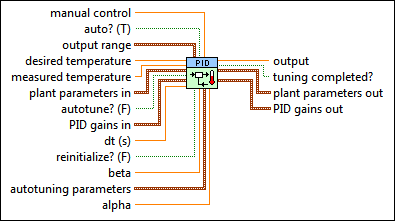 |
manual control specifies the value of the control output when auto? is FALSE.
|
 |
auto? specifies whether to use automatic or manual control. In some situations, you might need to switch off the PID controller and operate the system in manual, or open-loop, mode. The default is TRUE. When auto? is TRUE, this VI uses automatic control. When auto? is FALSE, this VI uses manual control. This VI uses bumpless transfer from manual control to automatic control.
|
 |
output range specifies the range to which to coerce the control output. The default range is –100 to 100, which corresponds to values specified in terms of percentage of full scale. You can change this range to something that is appropriate for your control system. For example, you can relate engineering units to engineering units instead of percentage to percentage. This VI implements integrator anti-windup when the controller output is saturated at the specified minimum or maximum values.
 |
output high specifies the maximum value of the controller output. The default is 100.
|
 |
output low specifies the minimum value of the controller output. The default is –100.
|
|
 |
desired temperature specifies the desired temperature (setpoint value) of the system.
|
 |
measured temperature specifies the measured temperature (measured value of the process variable) of the system. This value is equal to the feedback value of the feedback control loop.
|
 |
plant parameters in specifies the gain, time constant, and time delay (dead time) of the plant.
 |
process gain specifies the process gain (K).
|
 |
time constant (s) specifies the time constant (T), in seconds.
|
 |
delay time (s) specifies the delay time (L), in seconds.
|
|
 |
autotune? specifies to begin autotuning. Wire this input from a Boolean control with latched mechanical action and a default value of FALSE. The default is FALSE.
|
 |
PID gains in specifies the proportional gain, integral time, and derivative time parameters of the controller.
 |
proportional gain (Kc) specifies the proportional gain of the controller. The default is 1. In the equation that defines the PID controller, KC represents the proportional gain.
|
 |
integral time (Ti, min) specifies the integral time in minutes. The default is 0.01.
|
 |
derivative time (Td, min) specifies the derivative time in minutes. The default is 0.
|
|
 |
dt (s) specifies the loop-cycle time, or interval in seconds, at which this VI is called. If dt (s) is less than or equal to zero, this VI calculates the time since it was last called using an internal timer with 1 ms resolution. If dt (s) must be less than 1 ms, specify the value explicitly. The default is -1.
|
 |
reinitialize? specifies whether to reinitialize the internal parameters, such as the integrated error, of the controller. Set reinitialize? to TRUE if your application must stop and restart the control loop without restarting the entire application. The default is FALSE.
|
 |
beta specifies the relative emphasis of setpoint tracking to disturbance rejection. The default value of 1 is appropriate for most applications. You can use a smaller value between 0 and 1 to specify emphasis on disturbance rejection, such as process load changes. The VI uses this value in the two degree-of-freedom algorithm.
|
 |
autotuning parameters specifies various parameters used for the autotuning process.
 |
type of controller specifies which parameters to return as the output of the tuning process.
| 0 | P—Specifies to return only the proportional parameters. | | 1 | PI—Specifies to return the proportional and integral parameters. | | 2 | PID—Specifies to return the proportional, integral, and derivative parameters. |
|
 |
time constant factor specifies a divider to apply to the identified time constant to obtain the desired time constant response. Setting time constant factor to a value greater than 1 makes the desired time constant used in the design faster. Setting time constant factor to a value less than 1 makes the response slower.
|
 |
step amplitude specifies the amplitude of the setpoint relay action. The setpoint relay is between setpoint - amplitude and setpoint + amplitude.
|
|
 |
alpha specifies the derivative filter time constant. Increasing this value increases damping of derivative action. alpha can be a value between 0 and 1 or NaN, which specifies that no derivative filter is applied.
|
 |
output returns the control output of the PID algorithm that is applied to the controlled process. If this VI receives an invalid input, output returns NaN.
|
 |
tuning completed? returns TRUE when the autotuning process is complete. You can use this output to determine when to update the PID gains in.
|
 |
plant parameters out returns the calculated gain, time constant, and dead time of the plant.
 |
process gain returns the calculated process gain (K).
|
 |
time constant (s) returns the calculated time constant (T), in seconds.
|
 |
delay time (s) returns the calculated delay time (L), in seconds.
|
|
 |
PID gains out returns the updated PID gain parameters upon completion of the autotuning process. Normal output values are identical to the values in the PID gains in input.
 |
proportional gain (Kc) returns the proportional gain of the controller.
|
 |
integral time (Ti, min) returns the integral time in minutes.
|
 |
derivative time (Td, min) returns the derivative time in minutes.
|
|

 Add to the block diagram
Add to the block diagram Find on the palette
Find on the palette






